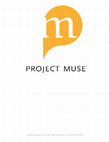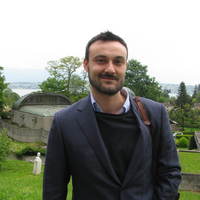Papers by Matthew Masucci
Journal for the Study of Sports and Athletes in Education, 2009

Journal of Sport & Social Issues, 2003
ABSTRACT In his autobiography, It’s Not About the Bike: My Journey Back to Life, Lance Armstrong ... more ABSTRACT In his autobiography, It’s Not About the Bike: My Journey Back to Life, Lance Armstrong claimed that his identity as a human being is not defined simply in terms of his skill at racing a bicycle. Armstrong’s articulation of multiple, competing identifications is consistent with a postmodern notion of fractured, incomplete identity. However, following Butler, identity can be seen as contested, negotiated, and often hegemonic. Drawing from the emerging field of cyborgology, and the work of Birrell and McDonald, the authors construct a parallel cyborg “counternarrative” alongside the popular Armstrong story. By interrogating Armstrong’s story through the lens of cyborg theory, the authors will explore and articulate alternative meanings/readings of Armstrong’s narrative of self as represented in his book and, finally, suggest that Armstrong’s story can be read as an exemplar of the postmodern cyborg sporting hero.

Given the increased popularity of Mixed Martial Arts (MMA) in the United States and
abroad, the p... more Given the increased popularity of Mixed Martial Arts (MMA) in the United States and
abroad, the purpose of this study was to investigate newspaper coverage of the most profitable
MMA organization in the U.S., the Ultimate Fighting Championship (UFC), from
1993– 2006. To better understand how the print media framed this controversial sport, a
critically informed content analysis of 320 newspaper articles was conducted. Drawing
from critical sport studies and media theory (Lowes, 1999; Rowe, 2007; Trend, 2007), the
researchers analyzed how various categories of newsprint coverage have shifted over the
13- year period. One clear conclusion was the ability of the mainstream print media to effectively
contour the popular discourse of this sporting practice, often playing a key role in
the public’s appraisal of the UFC during various points in its brief history. Moreover, the
mainstream press often served to unwittingly promote the UFC through a lack of critical
journalistic practices.

In the past five years, triathlon has been identified in the World Anti-Doping Agency’s
(WADA) an... more In the past five years, triathlon has been identified in the World Anti-Doping Agency’s
(WADA) annual doping summary as being among the top five sports returning ‘adverse
analytical findings’ or positive doping results. The primary purpose of this study was to
investigate the sources of knowledge regarding doping practices and anti-doping
efforts in Canadian and American professional female triathletes. The secondary
purpose of this study was to develop suggestions that may enhance the efficacy of antidoping
education programmes and ultimately the larger global anti-doping movement.
The first phase of this WADA-sponsored Social Science initiative project consisted of
two six-member focus groups that included younger pro-triathletes at the beginning of
their international career from both the USA and Canada. Six Canadian and six US
female triathletes participated in separate focus group sessions lasting approximately
1.5 hours in addition to individual semi-structured follow-up interviews. Analysis of
the data yielded four interconnected thematic categories, including: (1) meanings of
doping to participants; (2) general knowledge of doping and anti-doping practices; (3)
suggestions for anti-doping education; and (4) contrasts between American and Canada
assessment of anti-doping issues.

Despite the growing body of sport studies literature engaging cyborg theory, and notwithstanding ... more Despite the growing body of sport studies literature engaging cyborg theory, and notwithstanding the significant amount of work within sport sociology interrogating sport and space, few scholars have attempted to situate the lived experiences of cyborg athletes both within the wide range of indoor, often more technologized settings, and outdoors in what have been considered “wilderness” environments. Furthermore, little work has examined the relationship between sport identities, sporting environments, and environmental politics. Therefore, this study qualitatively examined the lived
sporting experiences of 12 competitive athletes who trained and competed both indoors
and outdoors while using an array of sporting technologies. Results showed that athletes
negotiated the boundaries between human, technology, and nature in complex,
often contradictory ways, and made moderate connections between their cyborg identities
and their impact on the environment.











Uploads
Papers by Matthew Masucci
abroad, the purpose of this study was to investigate newspaper coverage of the most profitable
MMA organization in the U.S., the Ultimate Fighting Championship (UFC), from
1993– 2006. To better understand how the print media framed this controversial sport, a
critically informed content analysis of 320 newspaper articles was conducted. Drawing
from critical sport studies and media theory (Lowes, 1999; Rowe, 2007; Trend, 2007), the
researchers analyzed how various categories of newsprint coverage have shifted over the
13- year period. One clear conclusion was the ability of the mainstream print media to effectively
contour the popular discourse of this sporting practice, often playing a key role in
the public’s appraisal of the UFC during various points in its brief history. Moreover, the
mainstream press often served to unwittingly promote the UFC through a lack of critical
journalistic practices.
(WADA) annual doping summary as being among the top five sports returning ‘adverse
analytical findings’ or positive doping results. The primary purpose of this study was to
investigate the sources of knowledge regarding doping practices and anti-doping
efforts in Canadian and American professional female triathletes. The secondary
purpose of this study was to develop suggestions that may enhance the efficacy of antidoping
education programmes and ultimately the larger global anti-doping movement.
The first phase of this WADA-sponsored Social Science initiative project consisted of
two six-member focus groups that included younger pro-triathletes at the beginning of
their international career from both the USA and Canada. Six Canadian and six US
female triathletes participated in separate focus group sessions lasting approximately
1.5 hours in addition to individual semi-structured follow-up interviews. Analysis of
the data yielded four interconnected thematic categories, including: (1) meanings of
doping to participants; (2) general knowledge of doping and anti-doping practices; (3)
suggestions for anti-doping education; and (4) contrasts between American and Canada
assessment of anti-doping issues.
sporting experiences of 12 competitive athletes who trained and competed both indoors
and outdoors while using an array of sporting technologies. Results showed that athletes
negotiated the boundaries between human, technology, and nature in complex,
often contradictory ways, and made moderate connections between their cyborg identities
and their impact on the environment.
abroad, the purpose of this study was to investigate newspaper coverage of the most profitable
MMA organization in the U.S., the Ultimate Fighting Championship (UFC), from
1993– 2006. To better understand how the print media framed this controversial sport, a
critically informed content analysis of 320 newspaper articles was conducted. Drawing
from critical sport studies and media theory (Lowes, 1999; Rowe, 2007; Trend, 2007), the
researchers analyzed how various categories of newsprint coverage have shifted over the
13- year period. One clear conclusion was the ability of the mainstream print media to effectively
contour the popular discourse of this sporting practice, often playing a key role in
the public’s appraisal of the UFC during various points in its brief history. Moreover, the
mainstream press often served to unwittingly promote the UFC through a lack of critical
journalistic practices.
(WADA) annual doping summary as being among the top five sports returning ‘adverse
analytical findings’ or positive doping results. The primary purpose of this study was to
investigate the sources of knowledge regarding doping practices and anti-doping
efforts in Canadian and American professional female triathletes. The secondary
purpose of this study was to develop suggestions that may enhance the efficacy of antidoping
education programmes and ultimately the larger global anti-doping movement.
The first phase of this WADA-sponsored Social Science initiative project consisted of
two six-member focus groups that included younger pro-triathletes at the beginning of
their international career from both the USA and Canada. Six Canadian and six US
female triathletes participated in separate focus group sessions lasting approximately
1.5 hours in addition to individual semi-structured follow-up interviews. Analysis of
the data yielded four interconnected thematic categories, including: (1) meanings of
doping to participants; (2) general knowledge of doping and anti-doping practices; (3)
suggestions for anti-doping education; and (4) contrasts between American and Canada
assessment of anti-doping issues.
sporting experiences of 12 competitive athletes who trained and competed both indoors
and outdoors while using an array of sporting technologies. Results showed that athletes
negotiated the boundaries between human, technology, and nature in complex,
often contradictory ways, and made moderate connections between their cyborg identities
and their impact on the environment.